|
[For the
uninitiated, a 'blog' (or weblog)
is a web journal with links. This gives me a chance to add short, 'off the record' style items that
wouldn't merit a separate article. I try my best to keep entries informal,
frequent, brief and (hopefully) interesting. For more information
about Jamie Goode, see the about the author
section. ]
Monday
21st March 2005
It's been a quiet week, wine-wise. Just one tasting of
note - a press tasting put on by Asda at the Hellenic centre in
Marylebone. Some pretty good wines, too. Regular readers here will
know my fascination with the closure debate (remember, I'm strange),
and in this context the Asda press tasting was of interest. I had my
first encounter with bottles sealed with Sabatť's
Diam closure, which is being used by Australian winery Hanging
Rock for most of their wines. Initially, I had to do a double take:
you don't normally associate Altecs with premium wines. But these
specially treated versions are actually pretty good closures. Indeed,
the closure debate is much more complex and nuanced than corks bad,
screwcaps good. It's more a question of finding the optimum closure
for a particular wine type. Then there are issues like oxtrans,
flavour scalping and reduction that are also important. Chatting to
one of the buyers, I found out that several of the screwcapped wines
in this line-up had to be decanted a few times to get rid of reduction
aromas [these are caused by the presence of sulphur compounds that
develop in a reductive (no oxygen) environment]. Closure choice,
folks, is an important winemaking decision. There's lots of
misinformation out there, so beware.
Monday 14th March
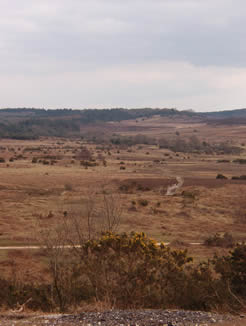 Spent
the weekend with a couple of other families in the New Forest
(pictured). The highlight of the weekend was a three-hour round trip
on mountain bikes, made even more interesting by the fact that of the
seven kids (all boys, aged 2-9), five of them were propelling
themselves on their own bikes. They did really well. When we got back
last night it was time for a glass of wine. I cracked open the Peter
Lehmann Barossa Shiraz 2002, which is currently on special at Waitrose
(£5.99, from £7.99). I really didn't like it. It's a grotesque
caricature of an Australian wine, with everything big, out of
proportion, and ultimately rather unpleasant. First we have the
dominant feature: the tarry, spicy, slightly bitter American oak. I
guess it adds a counterpoint to the sweet, rather jammy fruit - this
weighs in at 14.5% alcohol. Then there's the added acid that sticks
out on the finish. I don't mind big, but it has to be big and
balanced. I know some people may enjoy this wine for its obvious
upfront appeal, but I don't think it tastes very nice, and (I'll say
rather controversially) this is the sort of style you should grow out
of fairly quickly as your palate begins to develop. Spent
the weekend with a couple of other families in the New Forest
(pictured). The highlight of the weekend was a three-hour round trip
on mountain bikes, made even more interesting by the fact that of the
seven kids (all boys, aged 2-9), five of them were propelling
themselves on their own bikes. They did really well. When we got back
last night it was time for a glass of wine. I cracked open the Peter
Lehmann Barossa Shiraz 2002, which is currently on special at Waitrose
(£5.99, from £7.99). I really didn't like it. It's a grotesque
caricature of an Australian wine, with everything big, out of
proportion, and ultimately rather unpleasant. First we have the
dominant feature: the tarry, spicy, slightly bitter American oak. I
guess it adds a counterpoint to the sweet, rather jammy fruit - this
weighs in at 14.5% alcohol. Then there's the added acid that sticks
out on the finish. I don't mind big, but it has to be big and
balanced. I know some people may enjoy this wine for its obvious
upfront appeal, but I don't think it tastes very nice, and (I'll say
rather controversially) this is the sort of style you should grow out
of fairly quickly as your palate begins to develop.
Friday 11th March
I
am currently very, very bored with the tedious task of going through
each of the banner-bearing pages on this site and changing the code
that calls the banners up. But it's a task that has to be done. Just
thought I'd share this. Bored, bored, bored. The good news is that I
have some new sponsors and I'm currently not far off the maximum
number I can carry on the site, even with the present high level of
traffic.
Can't
not comment on Keegan's
departure, which came as a bit of a shock
(sorry, this is football talk. Please feel free to skip this para).
King Kev was made for City. We've had plenty of highs, but also many
lows; it has never been boring. He came to City, spent £50 m trying
to turn us into a top-four club. It didn't work out - I suspect he realizes that
over the last five years the complexion of the top flight has changed
such that it's been reduced to a money game. The collapse of the old
transfer market, shifting the power to the top players and agents,
means that the few elite clubs get the very best players - a club
outside the top three in the UK doesn't stand much chance of hanging
on to their superstars. The net result is that in the UK, Chelsea,
Arsenal and Man UTD are untouchable, and the rest of the premiership
is a battle for places 4-20. So Kev's going. My everlasting memory of
the Keegan years is the remarkable City v
Spurs match I went to last
season. City, down to 10 men, missing their best player, and losing
3-0 at half time looked dead and buried; they came back to win
4-3. And I was there!
Last
night, tried the first of a six pack of Espor„o's Touriga Nacional
2001, a modern, almost Australian-styled wine from Portugal's Alentejo.
Satisfying and rich (if a bit manipulated: extended cold maceration
and lots of spicy oak), and very good value at less than a fiver a
bottle from Sainsbury's
online wine shop. It normally retails for £9.99.
Tuesday 8th March
Notes from a fine wine dinner
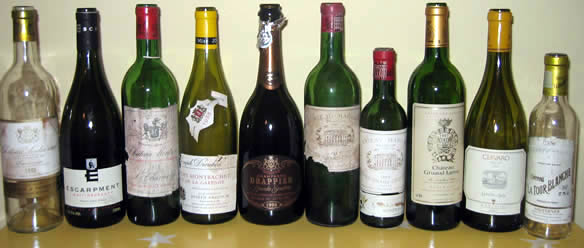
Admittedly a little after the event, but I thought I'd share some
notes from a fine wine dinner held at my brother-in-law, William
Beavington's gaff just before Christmas. He's got into the habit of
buying old bottles of wine from rather dodgy vintages from Peter
Wylie, and this was the second time I'd tried some of his purchases
(after being pleasantly surprised by a 1967 La Lagune on a previous
visit). We also had a few more recent wines. Looks like an awful lot
of bottles for four people (one of whom, my sister, was not drinking
because of pregnancy), but I don't think we finished them all. One
of the Margaux was completely shot; the Montrose was drinking very
well; the highlight was the 83 Suduiraut.
Escarpment Pinot Gris
Station Bush Vineyard 2002 Martinborough, New Zealand
(Tasted blind) Lovely smooth, slightly minerally nose makes me think
this is serious white Burgundy. The palate is quite broad and full
with upfront fruit and a minerally edge. Really nicely weighted
texture, and great balance. Perhaps a bit full and fruity for white
Burgundy, but a serious wine. Very good/excellent 92/100 (Lay &
Wheeler)
Ch‚teau
Drappier Grande Sendrťe 1998 Champagne
Quite a deep colour. Mellow, slightly toasty nose. Savoury, complex
palate with nice taut breadiness and great acidity. Pretty
sophisticated. Disgorged July 2004. Very good/excellent 92/100
La Tour Blanche 1998 Sauternes
Soft, fruity and waxy with a delicate nose that is lemony, grapey and
perfumed. The palate is rounded with lovely balance. Itís not an
obvious wine; quite subtle Ė perhaps light even Ė but nice acidity
provides balance. Very good/excellent 91/100
Drouhin Puligny Montrachet Clos de la Garenne 1988
Very deep yellow/gold colour. Very mature, part oxidised nose is
nutty, full and a bit volatile. The palate is mature and savoury with
good acidity, but it is a bit over the hill. Notes of coffee. Still
drinkable with food. Very good+ 85/100
Antorini Castello della Sela Cervaro 2001 Umbria
A blend of Grechetto and Chardonnay. Rich, rounded and nutty with lots
of new oak thatís integrated well. Very sophisticated in a rich,
Burgundian style. Sophisticated if slightly oaky. Very good/excellent
90/100
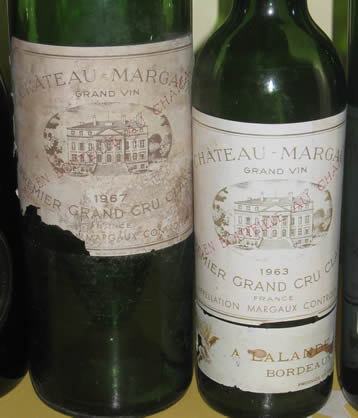 Ch‚teau
Margaux 1963 (half) Ch‚teau
Margaux 1963 (half)
Cork is in good condition. Very mature, oxidised nose. On the palate
old wine character dominates. Just about drinkable but certainly over
the hill. Poor
Ch‚teau
Margaux 1967
Recently recorked by Peter Wylie. Nice forward nose: spicy, slightly
herby. The palate has medium weight and is fully mature, but it is
quite elegant and still drinking OK. I like it. Rounded and mature
with good texture and a herbal edge. Lovely complexity on the nose,
but it is a bit off. Itís hard to rate old wines like these. Very
good+ 86/100
Ch‚teau
Montrose 1972 St Estephe
Quite structured with firm tannins and good acidity. Perhaps too acid.
Evolved herby, slightly earthy nose. A nicely balanced, mature claret
thatís chewy and structured. Very good+ 88/100
Ch‚teau
Gruaud Larose 1997 St Julien
Dark, spicy savoury nose is quite taut. Inviting with some herbiness
and a chalky, earthy minerality. The palate is dense and spicy with a
nice earthy, spicy richness. Drinking very nicely now, a really good
wine from this vintage. Very good/excellent 90/100
Ch‚teau
Suduiraut 1983 Sauternes
Wonderfully complex nose: bright, lemony, apricotty with toasty fruit.
Perfumed. The palate displays crystalline fruits with a subtle herby
edge. Sweet but with wonderful balancing acidity. Quite fresh and
youthful even. Lovely concentration and richness. Excellent 95/100
Ch‚teau
Suduiraut 1996 Sauternes
Luscious ripe, sweet lemon and tropical fruit on the nose. The palate
is viscous, rich and quite sweet. Good balancing acid and some
spiciness, together with a bit of caramel. Fantastic balance here.
Sweet, viscous, but with good acidity. A super wine. Very
good/excellent 93/100
Monday 7th March
Itís March already. A hopeful time of year here in the UK, as
the long British winter finally packs its bags and spring is on the
way (although winter seems to be keen to hang around this year Ė the
pond outside our house was frozen again today). I was out in the
garden at the weekend planting raspberry bushes and grape vines. When
we bought our house, one of the attractions was the 100+ ft (30 m)
garden, which is big for London. The bottom third had, however, become
overgrown Ė I think the previous owners had used it as a sort of
mini landfill site for their rubbish, and it was about four feet
higher than the rest. We got a guy with a digger in, and he separated
the gunk into three piles: topsoil, rubble and rubbish. A year later,
weíre almost there, having got rid of most of the rubbish and
redistributed the bulk of the topsoil. Iím planting vines more for
fun than anything else (I donít think a heavy loam over clay is
ideal for viticulture), but I expect to get a crop from the
raspberries: three different varieties are going in so we get a crop
from early summer to autumn. Raspberries are fantastic. I also like
strawberries, so Iím putting loads of these in too: they taste
wonderful when you pick them ripe. The supermarket versions look
lovely but invariably taste disappointing. The grape varieties going
in are Pinot Noir, Bacchus and Phoenix, propagated from my allotment
vines. Iím not one of these expert gardeners, like the folks on the
TV gardening programs (which I find hideously annoying Ė they are
always such precise people, Practically Perfect in Every Way); I just
enjoy watching the rhythms of nature proceed through the seasons, and
I find it relaxing to potter away in the garden for an hour or so.
Iím becoming a sad old git, arenít I?
Friday 4th March
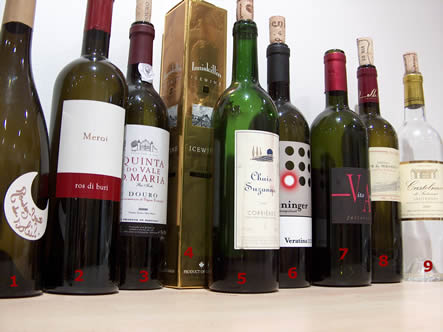
Time
to take another look of the random assortment of bottles in my tasting
corner on the worktop - this time mostly empties. From memory, so
apologies for mistakes. (1) Rendez vous du Soleil, an upmarket
Languedoc wine purchased from Caves Pyrene after a conversation online
with winemaker John Bojanowski. Nice stuff, chunky and earthy. (2)
Upmarket Italian red from Meroi, producer in the Colli Orientali
(northeast Italy). Fresh, vivid, intense fruit with classy oak in the
background. Very stylish. A sample from Cadman Fine Wines (a new
retailer). (3) Quinta
do Vale D. Maria 2000 from the Douro. Very stylish and elegant; a
bit woody on release it has developed nicely. (4) Inniskillin Vidal
Ice Wine, from Canada. Not tried yet. A gift (retail is £39, so a
generous one). (5) Chais Suzanne Corbieres 1999, made by an English
couple. Very earthy and spciy; a real food wine. Sample from new
retailer Purple wines. (6) Weninger
Veratina 2000, a red wine from Austria's Burgenland. Very fresh and
bright with deep, dark fruit. A gift from the winery when I visited in
October. (7) Vito Arturo, a fantastic Tuscan wine. Read about it here.
(8) A really lovely 2003 Claret (Tour de Mirambeau) showing forward
ripe fruit with a spicy, tannic tang. My chum Paul brought this to
dinner; purchased from Oddbins I believe. (9) Castelnau de Suduiraut
2000. This second wine of Sauternes star Suduiraut
has been a revelation. I bought four bottles for 11 Euros each at a
French supermarket last August and so far the three I've drunk have
been fantastic. This one didn't last long.
Wednesday 2nd March
 Spent
the evening reading page proofs of the book, which I will try my
hardest not to plug any more, lest you all grow weary with repeated
mentions of it. I've reached page 88 this evening, and I must say, on
re-reading my impression is that it's fantastic. It's just the book
I'd want to read on wine. It is full of fresh insights - many of these
areas haven't really been covered before. And it's impeccably
balanced. But then, I'm biased. I'm like the proud parent who shows
people pictures of their baby: we all know that babies look much
alike, and often just a bit ugly with their crinkled, needy visages -
but you try telling the proud parent that! Spent
the evening reading page proofs of the book, which I will try my
hardest not to plug any more, lest you all grow weary with repeated
mentions of it. I've reached page 88 this evening, and I must say, on
re-reading my impression is that it's fantastic. It's just the book
I'd want to read on wine. It is full of fresh insights - many of these
areas haven't really been covered before. And it's impeccably
balanced. But then, I'm biased. I'm like the proud parent who shows
people pictures of their baby: we all know that babies look much
alike, and often just a bit ugly with their crinkled, needy visages -
but you try telling the proud parent that!
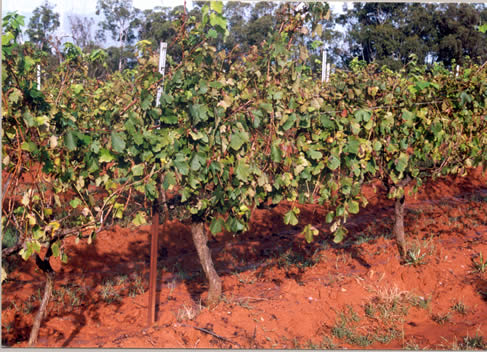 To
aid me in my work, I'm drinking my penultimate bottle of Glenguin's
1998 Orange Vineyard Cabernet Sauvignon. I bought 18 bottles of this
wine - for me a record - and I've enjoyed every one. I first tasted it
back in 2000, at the Boutique Winery
Centre in the Hunter Valley.
[Aside: have you noticed how my tasting notes have changed with the
years? Back in 2000, I didn't have too much to say about each wine.
Now I say rather too much. Hunter is pictured] Over the last
five years it has evolved wonderfully. It's a big bruiser of a wine
with massive concentration, dense, spicy fruit and high acidity.
There's some oak here (American, too - usually not a good thing) but
it meshes very well with the intensely rich, spicy fruit. The high
acid is what is keeping this wine fresh and alive, though. I reckon
it's got five years ahead of it, at least (it may turn out to be one
of those rare, indestructible wines that will drink well for decades).
Not subtle, but very appealing, and it's made me happy in my
work. To
aid me in my work, I'm drinking my penultimate bottle of Glenguin's
1998 Orange Vineyard Cabernet Sauvignon. I bought 18 bottles of this
wine - for me a record - and I've enjoyed every one. I first tasted it
back in 2000, at the Boutique Winery
Centre in the Hunter Valley.
[Aside: have you noticed how my tasting notes have changed with the
years? Back in 2000, I didn't have too much to say about each wine.
Now I say rather too much. Hunter is pictured] Over the last
five years it has evolved wonderfully. It's a big bruiser of a wine
with massive concentration, dense, spicy fruit and high acidity.
There's some oak here (American, too - usually not a good thing) but
it meshes very well with the intensely rich, spicy fruit. The high
acid is what is keeping this wine fresh and alive, though. I reckon
it's got five years ahead of it, at least (it may turn out to be one
of those rare, indestructible wines that will drink well for decades).
Not subtle, but very appealing, and it's made me happy in my
work.
p.s.
the website migrated. I've now got to change the code calling up the
advertising banners on some 700-odd pages. Will take some time.
Tuesday 1st March
Regarding the website migration, Iím still waiting, but Iíve been
told it will occur in the next 24Ė72 hours. My job is to keep a
beady eye out for when it happens: only then will I be able to
reconfigure my cgi scripts (these run the forms and advertising banner
rotations, among other things) and get things running smoothly. Iíll
have a lot of space to play with, so expect a graphically richer site,
and new features such as quizzes (I imagine readers fainting with
excitement) and even, perhaps, a bulletin board
Ė although I donít want to duplicate any of the several excellent
wine boards that already exist. Iíll have to think of a new angle
for this one.
The proofs of my book have arrived. Theyíve already
been read by an excellent proofreader at Mitchell Beazley, who has
come up with an extensive set of queries and comments (so thorough is
he that he pissed off another wine writer with too many queries; this writer told me with some relish that he insisted the
offending proofreader be lifted from his project). Iíll be busy
attending to these queries, and also some comments from anonymous
scientific reviewers hired by the University of California Press (who
are publishing the book in the USA), but hopefully the book will be
the better for all this tweaking.
Tonight I met two of the Languedocís top winegrowers: Thierry Hasard
of Domaine de la Marfťe and Pascal Fulla of Mas
líEcriture. Can the Languedoc produce wines that are the equal
in quality terms to the best of the classic French regions? You bet it
can. Their wines arenít cheap, at £20-ish a bottle, but wines of
the equivalent quality from Burgundy and Bordeaux are £40+.
Friday 25th February
Yesterday was a very enjoyable, wine-filled day. The procedings
started with a tasting of 50 Great Portuguese Wines (As Selected by
Richard Mayson). 20 of these were from the Douro; the other 30 a mix
of D„o, Bairrada/Beiras, Estremadura, Ribatejo and Alentejo. It was
really good to have a chance to take a look at the sort of quality
Portugal is capable of, and Iíll be reporting in full on this later.
I have to mention in passing that while Richardís selection was on
the whole very good, there were some odd ommissions, particularly
considering the inclusion of the rather weird-tasting, plonkish DFJ
Alicante Bouschet and a couple of other lesser-performing wines.
Afterwards I wandered over to the Bordeaux Index
tasting, nipping in to check out Harvey Nichols wine department on the
way (which is very impressive, with some lovely bottles, at prices
which arenít too outrageous). Iím impressed by Bordeaux Index;
they seem right on the ball. I didnít spend as long here as I wanted
because I had to get back to Waterloo, to meet Fiona, who was coming
to join me for the Portuguese Wine Awards dinner. This was held at the
Ambassadorís residence in Belgrave Square, and I was a nominee for
the journalism award, along with Tim Atkin, Matthew Jukes, Charles
Metcalfe and Richard Mayson. Somebody remind me next time not to get
my hopes up when Tim is one of the nominees (echoes of last Mayís
Glenfiddich): the dude is a walking awards magnet. He won an engraved
decanter (no cash prize) so I wasnít too upset to be a loser. In
fact, I was pleased just to be in such good company. Nice to see David
Penny of Handfords pick up the award for independent retailer, and
Nick Room of Waitrose the (rather larger) decanter as winner of the
award for the national retailer. Both have worked hard with their
Portuguese ranges.
Towards the end of the evening, I chatted to David
Baverstock, Australian wine maker at Espor„o in the Alentejo. Heís
probably better known in popular circles as being the winemaker behind
Sir Cliff Richardís Vida Nova wine. Cliff approached David a few
years back saying he wanted to make a wine, and that heíd like to
have the vines on his property in the Algarve Ė his preference was
for ĎAustralian varietiesí. David wisely steered Cliff towards a
mix of Shiraz and Aragones (he felt at least one Portuguese variety
was a good idea), and for the first few vintages Vida Nova was made at
Cortes de Cima in the Alentejo. This didnít work out brilliantly for
logistical reasons, and while the first release (2001) was a success,
2002 was disappointing. A purpose-built winery has now been
constructed, and David is very happy with the quality of 2004. The
success of Vida Nova, where other celebrity wines havenít done so
well, probably stems from (a) the loyalty of Cliffís fans and (b)
the fact that Cliff has taken the project seriously: through his
phenomenally successful musical career the music press has been quite
antagonistic; now with the wine project he has a chance to make good
wine without the background of press negativity that has accompanied
his musical endeavours. It will also keep the connection going with
his fans when it comes time to bring down the curtain on his
remarkable singing career. Of his involvement with Cliff, David says
he gets some good tennis, but no wild parties on yachts (did I
correctly spot a brief look of wistful regret?).
Wednesday 23nd February
I've finally finished my New Douro series with a report on the
New
Douro tasting in London. It's made me realize that no wine writer can
these days hope to be an expert on every region: there's just too much
to cover. You have to choose where you are going to focus. Those celeb
winewriters that aim to be comprehensive only manage too put out their
annual wine guides with the help of a skilled team of writers whose
work goes un-bylined.
Talking
of Portugal, Fiona and I are going to be dining at the Portuguese
embassy on Thursday. It seems I've been nominated for an award for the
journalism prize in the Portuguese wine awards. I don't know (a) how many other nominees
there are (there could be two dozen!) or (b) if there's a sizeable
prize to be had. Still, we should get a decent meal and some nice
wine, for which we will be thankful. Perhaps the ambassador will also
serve us some Ferrero-Rocher (sp?).
On
the awards front, I also found out that I'd been shortlisted for the
winewriting prize for the World Gourmet Food Summit 'Awards of
Excellence'. It's always nice to get recognition, although (again) I
don't know what the potential prize is. It's an event held in
Singapore in April, and the nomination came because of an article of
mine in Asia Tatler. I have global reach!
There
may be a brief service interruption over the next few days. I'm
migrating. Wineanorak has outgrown its original home. Traffic is high
and the amount of material here has accumulated to the point that I
kept running out of space. So I've moved to a new hosting account that
gives me 600 megabytes of space and 15 megabytes a month of data
transfer (currently I'm doing about 10; but this new service allows me
to upgrade if I'm getting close to the new limit). Of course,
migrating is a bit of a nightmare: it looks like I may have to change
all my cgi scripts, or (worse case scenario) change the html of every
page carrying a banner advert (and I don't have any tecchie help with
this site; you probably noticed!). But the short term pain is
justified by the long-term gain, and I'm hoping that most readers
won't even notice. If you do spot anything amiss, please let me know.
Sunday 20th February
I'm stiff. The good thing about having kids of the male
variety is that you run around a lot playing football. We had
some friends (with five children of their own, four boys and a
girl) for lunch today, and ended up playing nearly two hour's
worth of intensely competitive football on the green outside our
house. As my team was outnumbered five to three, there was a lot
of running to be done; now I suffer. With Sunday lunch, two nice
red wines.
|

The view from here: one of my workstations |
A red 2003 Baumes de Venise from Majestic showed
lovely Grenache fruit - earthy and spicy with a grainy sort of
structure that'e very appealing. Then another bottle of the Domaine
du Cros Marcillac Lo Sang del PaÔs, which is vivid, fresh and has
a remarkable nose of rain on sun-baked tarmac - gravelly and bloody.
I'm almost always in the mood for this wine.
On
Friday I met Neal Martin again for lunch. It was Japanese curry. Very
satisfying. I'm really impressed with what Neal's doing on his site.
His latest coup was to interview Michael Broadbent and get a
photograph of the first page of Michael's first tasting note book,
which dates back if my memory serves me correctly to 1952. Talking of
memory (or notebooks) serving correctly, I have independent
confirmation that I didn't misquote Michael (see post from 12
February, below). He may have used the word foisted, rather than
forced, though.
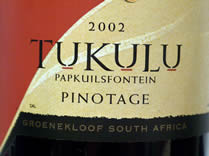 I've
been continuing my exploration of Pinotage, the despised variety that
I'm enjoying more than I thought I would. The Ken Forrester Petit
Pinotage 2004 is fantastic for £4.49 from Tesco, with it's vivid,
juicy fruit. The Tukulu 2002 from Oddbins is in a different,
more serious - almost Australian style - with lots of spicy, tarry
fruit. In fact, I wonder whether this has (a) seen plenty of new
American oak, (b) seen some microoxygenation or (c) both. It seems a
little prematurely aged, actually, although it's quite enjoyable in
this full-on style. I've tried three Oddbins Pinotages (this, the
Obikwa and the Oracle), all from giant Distell. They're good wines, if
little 'made'. Anyway, if you'd a Tesco store near you, look out for
the Forrester - for sheer fun it's hard to beat. I've
been continuing my exploration of Pinotage, the despised variety that
I'm enjoying more than I thought I would. The Ken Forrester Petit
Pinotage 2004 is fantastic for £4.49 from Tesco, with it's vivid,
juicy fruit. The Tukulu 2002 from Oddbins is in a different,
more serious - almost Australian style - with lots of spicy, tarry
fruit. In fact, I wonder whether this has (a) seen plenty of new
American oak, (b) seen some microoxygenation or (c) both. It seems a
little prematurely aged, actually, although it's quite enjoyable in
this full-on style. I've tried three Oddbins Pinotages (this, the
Obikwa and the Oracle), all from giant Distell. They're good wines, if
little 'made'. Anyway, if you'd a Tesco store near you, look out for
the Forrester - for sheer fun it's hard to beat.
Thursday 17th February
No one likes a moaner. In
the UK we have a phenomenon known as grumpy old
men. To be a grumpy
old man you donít have to be male and you donít have to be old.
You just have to be a bit of a complainer. And the chief object of
criticism of grumpy old men is Ďcrap Britainí Ė a term coined to
describe the varied negative aspects of our current society. Iíll be
honest: thereís a lot to dislike about contemporary life in the UK.
To focus on crap Britain and carp on about it is a rather negative
pursuit, however. It is far easier to point to what is wrong than it
is to come up with suggestions for positive change. I donít really
see the point in identifying societyís deficiencies and focusing
attention on the bad bits unless you are going to offer some hope for
change along with it.
Letís return to wine.
Itís quite possible to take a look at the global wine market and
come away depressed, with a long list of whatís wrong with it. For
example, it could be suggested that modern wines are all made from the
same few celebrity grape varieties and they taste worryingly similar.
But, as I pointed out in my opening paragraph, no one likes a moaner
and no matter how well argued your overview of the depressing state of
wine today is, people donít want to read that sort of thing. Iím
actually tremendously upbeat about some aspects of wine today. All
across the wine map there are emerging dozens of quality-minded
pioneers in regions that had only ever produced commodity wines until
a couple of decades ago. Look at Portugal; look at Franceís
Languedoc, look at the South West of France; look at Spain outside
Rioja. There is far more interesting, personality filled wine being
made today Ė and this more than offsets the worries about
international-style wines, consultant winemakers and the rise of the
brands. So my overall tone is positive. Donít be disappointed by the
odd 100 point claret that doesnít taste the way you think claret
should taste, or feel threatened by the influence of critics who you
perceive to be forcing global tastes on people. Focus on all the
wonderful wines that are out there Ė on the legion of quality minded
producers in wine regions everywhere who werenít around a decade
ago, even Ė and enjoy your wine.
Monday 14th February
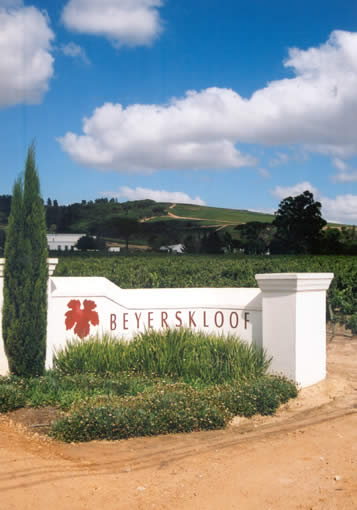 Surprise!
Two inexpensive Pinotages that I like. Generally, Pinotage sucks. Or,
should I say more diplomatically, it is a quirky grape that has an
unusual flavour profile. Normally, I like quirky, but thereís quirky
good and quirky bad. Sadly, most Pinotage falls into the latter
category. I quote myself on the subject: ĎPinotage is one of those
grape varieties that polarize people. Some people think itís vile,
while others are passionate about it and advocate it as the potential
unique selling point (USP) of the South African wine industry. Why
does it create such strong feelings? Itís because it commonly makes
wines with a unique and, to some, rather disturbing flavour profile
that is described as a combination of paint, bananas, sour cherries,
damsons, plums and pungent animal-like gamey notes.í
Continuing in a diplomatic theme, ĎPerhaps what Pinotage does best
is to make bright, fruit-forward berry fruited red wines that are fun
to drink and where the slightly funky, rustic Pinotage character acts
as a point of interest rather than a distraction.í So I donít
think Pinotage can make great wine, but it can make good wine. The two
wines that Iíve drunk over the last few days with some pleasure are
the Beyerskloof Pinotage 2003 and the Swartland Winery
Pinotage 2002. The first is brilliantly balanced, with a nice,
medium bodied palate and just enough spicy structure to keep things
interesting. Itís a delicious, almost Claret-like rendition of
Pinotage without too much funk. The latter is a riper, more fruit
forward style, with delicious juicy berry and blackcurrant fruit with
a savoury twist. Itís very drinkable and a subtle green herbal
streak is the only concession to Pinotage funk. Former is £5.99,
latter £4.49 from Majestic Ė both well worth a punt at that price. Surprise!
Two inexpensive Pinotages that I like. Generally, Pinotage sucks. Or,
should I say more diplomatically, it is a quirky grape that has an
unusual flavour profile. Normally, I like quirky, but thereís quirky
good and quirky bad. Sadly, most Pinotage falls into the latter
category. I quote myself on the subject: ĎPinotage is one of those
grape varieties that polarize people. Some people think itís vile,
while others are passionate about it and advocate it as the potential
unique selling point (USP) of the South African wine industry. Why
does it create such strong feelings? Itís because it commonly makes
wines with a unique and, to some, rather disturbing flavour profile
that is described as a combination of paint, bananas, sour cherries,
damsons, plums and pungent animal-like gamey notes.í
Continuing in a diplomatic theme, ĎPerhaps what Pinotage does best
is to make bright, fruit-forward berry fruited red wines that are fun
to drink and where the slightly funky, rustic Pinotage character acts
as a point of interest rather than a distraction.í So I donít
think Pinotage can make great wine, but it can make good wine. The two
wines that Iíve drunk over the last few days with some pleasure are
the Beyerskloof Pinotage 2003 and the Swartland Winery
Pinotage 2002. The first is brilliantly balanced, with a nice,
medium bodied palate and just enough spicy structure to keep things
interesting. Itís a delicious, almost Claret-like rendition of
Pinotage without too much funk. The latter is a riper, more fruit
forward style, with delicious juicy berry and blackcurrant fruit with
a savoury twist. Itís very drinkable and a subtle green herbal
streak is the only concession to Pinotage funk. Former is £5.99,
latter £4.49 from Majestic Ė both well worth a punt at that price.
Saturday 12th February
Last night was spent slobbing in front of the TV, watching an
entertaining, well thought out thriller called Cellular.
The plot: a kidnapped family are rescued through a random call to a
mobile phone (known as cell phone in the US, hence the movie title
which doesnít translate well to the UK). The rescuing hero spends a
good three quarters of the movie taking this call; I suspect there was
just a touch of product placement here. Anyway, I mention it here
because it introduces the topic of how modern communication technology
has the potential to impact our lives. For one thing, it brings
individuals in the media into sometimes uncomfortably close contact
with the people they are communicating with. These days, you can say
something at a dinner in London on Thursday and find it on a bulletin
board being discussed by an international community of wine lovers on
Friday morning. You used to just talk to people; now you have to talk
with them.
A while back I made the mistake of posting on a wine
bulletin board some comments Iíd made in this blog stemming from a quote
by one of the giants of the wine world, Michael Broadbent. This started
a long thread in which some American participants dismissed
Broadbent as a dinasour, among other rather personal comments. Bartholemew
Broadbent, his son (who runs an importing business in the USA) recently
discovered the bulletin board in question and printed off this thread,
some 30 pages in all, and faxed them to his father. Broadbent senior then
replied to the thread in person. The first I heard of this was an email
from Neal Martin, who was interviewing Broadbent senior for an article on
his very worthy site, www.wine-journal.com:
apparently this had come up in the conversation. Bill Nanson of Burgundy
report fame also picked up on the thread; he was at the same
dinner as I where the original remarks by Broadbent were made.
Why mention this here? Well, naturally Broadbent was
upset that strangers had been making personal comments about him, and
justifiably. But he was also critical of me for quoting him in the first
place. Was this fair? If Iím honest, I can see two sides here. Broadbent
claims it was a private dinner, and it was discourteous to quote from his
short speech. In my defence, I was invited to the dinner as a journalist;
there were some 100 people present, including at least one other journo. I
therefore expected everything to be said to be on the record. Broadbent is
famous; his opinions matter. Journalists will quote him. Itís
inevitable. From his side, I can see why it might be deemed discourteous
to be put on the record. It was the end of a lengthy dinner and he agreed
on the spot to say a few words at the end. It was a generous gesture by
him. He probably didnít expect to have journalists present at an £185 a
head black tie affair. On reflection, I should have cut him some slack and
not picked up on this comment. But Iím a journalist at heart. To pick up
on comments As an aside, Iím none to keen on famous, influential figures
saying one thing for the public but privately holding quite different
opinions.
His second criticism was that heíd been misquoted.
Journalists have no way of proving that theyíve quoted 100% accurately
unless they have a tape recording. Shrewdly, perhaps, Broadbent then
says that I canít be sure he said this unless I have a recording,
which he claims would have been made illegally. Either way, heís got
me: I misquoted him (I canít prove otherwise, although I believe my
notes to be totally verbatim for this sentence: although I canít write
everything down verbatim in note taking, sentences I intend to quote I
put down word for word), or I prove by a tape I got it right, which then
makes me unethical because I smuggled in a prohibited tape recorder, and
if I stoop to this then Iím not a trustable source. Actually, there
was no ban on recording this event. I take my responsibilities as a wine
hack seriously and would never seek to twist a quote or use it in the
wrong context to make a bigger story. But looking at it from
Broadbentís point of view, I used one statement of his to then begin a
discussion, so it could be seen to be out of context. In all, an
unfortunate episode, and Iím sorry for my part in starting it. Lesson
learned.
Thursday 10th February
Had a wine-rich couple of days. Yesterday evening started off with
a
Roussillon
tasting hosted by Liz Berry of Grand Cru Wines. The highlight for me
was getting to meet Eric Monnť of Clot
de LíOum, and tasting his wines again. Heís a smart,
approachable chap, and he and his wife are making some very smart,
intense red wines from 30 different vineyard parcels. Clot de LíOum
has only been going a short while, and to finance his wine habit Eric
still works part time at the European Patent Office, which probably
explains why his English is so good. Vineyard land can be had in the
Roussillon
for around £3000 per hectare, and it costs around £15 K to plant a
hectare from scratch (or replant; a lot of the vineyards arenít in
great shape). Potential for quality is immense. I wish I had more
money and more time, because this would then be very tempting.
Then I headed off for an Austrian wine tasting dinner
at Mju restaurant in Kinghtsbridge. Five producers were present:
Schloss Gobelsburg, Helmut Lang, Polz, Stadt Krems and Umathum. All
the wines were superb. The idea was to match the wines to a
complicated fusion-y six course menu. Iím not sure this worked too
well Ė too many variables to consider. I was sitting at a table with
Serena Sutcliffe, David Peppercorn, a young sommelier from the Square
(whose name I forget), Nick Room (Waitrose wine buyer), David Moore
(co-owner of the two-starred Pied-ŗ-Terre restaurant, currently
closed for nine months by a fire) and Michael Moosbrugger of Schloss
Gobelsburg (a charming, thoughtful guy who Iíve now met on a number
of occasions. Serena was very forthcoming on a number of topics Ė I
was very interested to hear her views on recorking (she thinks itís
a terrible thing because of the risk of counterfeiting) seeing as I
recently did a piece on this for the World of Fine Wine magazine. A
very enjoyable evening, but another potentially tricky journey home
caused by leaving too late, but I didnít want to miss the TBA Pinot
Noir at the end.
Today was the Austrian trade tasting. Austrian wines
really are fabulous and Iím planning a series on them, based in the
first instance around my recent trip. Today, I restricted myself to
some cherry picking, because I was short of time: FX Pichler, Emmerich
Knoll, Nikolaihof and Scheiblhofer. All were fantastic in their own
way.
Sunday 6th February
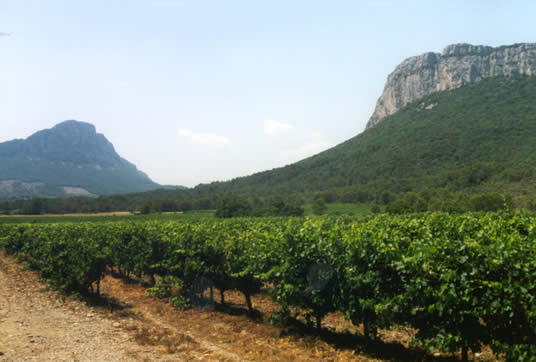 Two
from Pic St Loup in the Languedoc
this weekend. I Ďdiscoveredí this region (of course, it was no
secret; just Iíd never heard of it before) on a camping holiday in
1997. I went back in 1998, and then in 2002. Itís a part of the
Languedoc that makes some of southern Franceís most expressive red
wines, helped by the slightly cooler climate this region experiences.
The first wine was Domaine de líHortus Grande Cuvťe 1998.
Seven years on this wine is tight, intense and savoury, with pungent
olive and herb notes over the rather evolved meaty fruit. Itís a
big, bloody food wine, probably at peak or a little past it, and
enjoyable drinking. Reminiscent of a souped-up, high end Burgundy with
some bottle age. Bought from Caves Pyrene a month ago, itís
interesting to note that the back label is from the American importer,
Eric Solomon. The Two
from Pic St Loup in the Languedoc
this weekend. I Ďdiscoveredí this region (of course, it was no
secret; just Iíd never heard of it before) on a camping holiday in
1997. I went back in 1998, and then in 2002. Itís a part of the
Languedoc that makes some of southern Franceís most expressive red
wines, helped by the slightly cooler climate this region experiences.
The first wine was Domaine de líHortus Grande Cuvťe 1998.
Seven years on this wine is tight, intense and savoury, with pungent
olive and herb notes over the rather evolved meaty fruit. Itís a
big, bloody food wine, probably at peak or a little past it, and
enjoyable drinking. Reminiscent of a souped-up, high end Burgundy with
some bottle age. Bought from Caves Pyrene a month ago, itís
interesting to note that the back label is from the American importer,
Eric Solomon. The 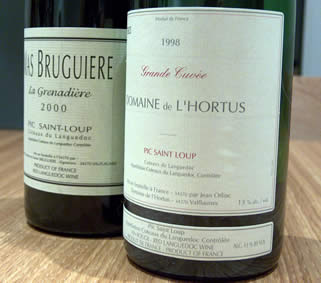 next
day it was caremelized, port-like and noticeably oxidised. The second
wine was one of my favourites from the region: Mas BruguiŤreís
La GrenadiŤre 2000. This has meaty, spicy fruit with a
distinctive olive-like tang and noticeable earthiness. A dark, intense
with that is still drinking well, but perhaps just a little past its
peak. Purchased at the domaine in 2002. Most wines from Pic St Loup
are good; but avoid 2002, a tricky vintage in these parts, and go for
more recent vintages in preference to older ones. Prompted by this
note, Iíve just opened a third Pic St Loup. Its Les Desmoiselles
de Lavabre 1999 (second wine of this estate) which I bought
cheaply in an H&H Bancroft sale. Open red berry fruit nose with a
distinctive earthiness. A peppery tang to the fresh fruit palate, but
this is nothing more than a slightly dilute earthy peppery table wine.
An honest, unpretentious drop, kept lively and fresh by the good acid.
I like it, but itís not in the same league as the first two. It will
be a nice accompaniment to Match of the Day this evening, where Iíll
enjoy seeing City hold high-flying Chelsea to a draw at Stamford
Bridge. next
day it was caremelized, port-like and noticeably oxidised. The second
wine was one of my favourites from the region: Mas BruguiŤreís
La GrenadiŤre 2000. This has meaty, spicy fruit with a
distinctive olive-like tang and noticeable earthiness. A dark, intense
with that is still drinking well, but perhaps just a little past its
peak. Purchased at the domaine in 2002. Most wines from Pic St Loup
are good; but avoid 2002, a tricky vintage in these parts, and go for
more recent vintages in preference to older ones. Prompted by this
note, Iíve just opened a third Pic St Loup. Its Les Desmoiselles
de Lavabre 1999 (second wine of this estate) which I bought
cheaply in an H&H Bancroft sale. Open red berry fruit nose with a
distinctive earthiness. A peppery tang to the fresh fruit palate, but
this is nothing more than a slightly dilute earthy peppery table wine.
An honest, unpretentious drop, kept lively and fresh by the good acid.
I like it, but itís not in the same league as the first two. It will
be a nice accompaniment to Match of the Day this evening, where Iíll
enjoy seeing City hold high-flying Chelsea to a draw at Stamford
Bridge.
Previous entries

Back to top |